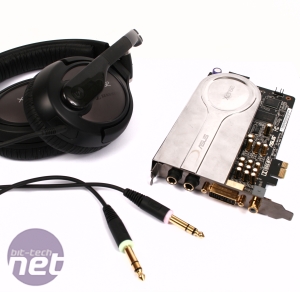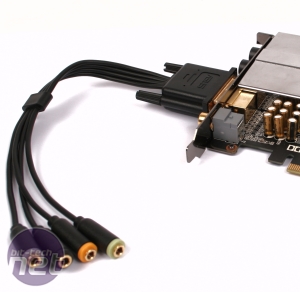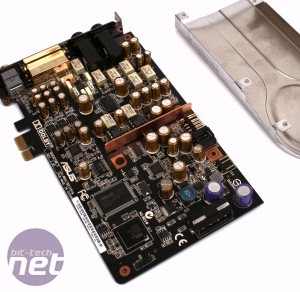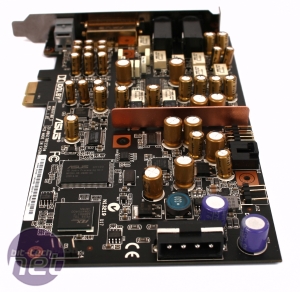
Asus Xonar Xense Audio Bundle Review
Manufacturer: AsusUK Price (as reviewed): £199 inc VAT
US Price (as reviewed): Unknown
Note: this review was first published on 31 May 2010 as Asus kindly gave us early access to the hardware. Three months later, the kit is on sale at Overclockers for £200 rather than the £275 we were originally quoted, so we've revised our conclusion and scores.
This bundle combines Asus' new Xense One sound card with Sennheiser's widely acclaimed PC 350 gaming headset. This is a slightly strange combination, as the sound card would usually appeal to audio enthusiasts, while the headset's marketing spiel implies that it's best used for virtual explosions.
The card's main emphasis is on two 1/4in stereo ports - one for the headphone connector, and the other for the microphone. A coaxial S/PDIF output at the bottom can route digital audio directly to an amplifier, bypassing the card's analogue stages. Four 3.5mm surround-sound connections are supplied via a breakout cable that connects to the DVI-like port.


The Xonar Xense uses a breakout cable for standard 3.5mm mini-jack connections, but two 1/4in jacks for the bundled Sennheiser PC 350 headset.
The Xense One uses Asus' AV100 processor, which is actually a rebadged C-Media CMI-8788 OxygenHD, along with a PLX PEX 8112 PCI-E bridge chip, to provide PCI-E support. The front headphone channel has its own dedicated Digital to Analogue Converter (DAC) in the form of a Texas Instruments PCM1796, along with a low-distortion Texas Instruments 6120A2 amplifier.
The other channels share a Cirrus-Logic CS4362A, which also appears on Asus' £55 Xonar DX card. A pair of replaceable JRC 2114D OP-AMPs rounds out the specification. The card has a 192KHz/24-bit sample rate on all inputs and outputs, and the front headphone channel has a signal-to-noise ratio (SNR) of 118dB. You'll need a spare Molex connector to power the card.
If this all sounds a little familiar, it's because the core hardware specification is almost identical to Asus' stunning Essence STX card, which was released last year. As with the Essence, the quality of the components account for a large part of the Xense's price.


With the EMI shield removed we can see the various DACs, ADCs and OP-AMPS, note that the Xense One requires a spare Molex to power it.
There are plenty of extra features built into the driver - most importantly, Dolby Digital Live, Dolby Headphone, Dolby Virtual Speaker, Dolby Pro-Logic II and Asus' home-brewed emulation of Creative's EAX 5.0 environmental audio standard for games. There's also a low-latency ASIO driver for recording, and various modes allow you to switch between audio profiles designed to optimise the EQ settings, echo and Dolby Headphone for music, movies and different types of games.
The Xense One can deliver massive output gain; it's capable of powering headphones with an impedance of up to 600 ohms, an ability that you're more likely to find in a radio studio than in a gaming enthusiast's home. The customised Xense version of the PC 350 headset has 1/4in headphone and microphone connectors, and a high impedance of 150 ohms.
By comparison, headphones designed for use with an MP3 player typically have an impedance of 32 ohms. For optimal sound quality, your headphones and output source should have matched impedances - too little power to the headphones will make them sound weedy, while too much will cause distortion.
Specifications
- Processor Asus AV100 (C-Media CMI-8788 OxygenHD)
- Memory None
- Interface 1x PCI-E
- Maximum channels Eight (24-bit bit-rate)
- Maximum sample rate 192KHz
- Inputs 1/4in mic in
- Outputs 1/4in headphone out, co-axial S/PDIF; breakout cable: 4 x 3.5mm mini-jack analogue surround out
- Audio technologies Dolby Digital Live, Dolby Headphone, Dolby Virtual Speaker, Dolby Pro-Logic IIx, DirectSound3D GX 2.5, EAX 2.0 and 1.0, DirectSound HW, DirectSound SW, A3D 1.0, OpenAL generic modes, 128 3D sounds processing capability (EAX 5.0 software emulation), SoundFont, ASIO 2.0 driver support

MSI MPG Velox 100R Chassis Review
October 14 2021 | 15:04








Want to comment? Please log in.